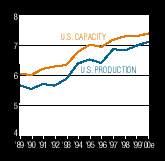| |

| FORECAST (000 tons) |
| U.S. |
1998 |
1999e |
2000e |
| Production |
6,896 |
7,000 |
7,158 |
| Capacity |
7,320 |
7,309 |
7,433 |
| Utilization rate, % |
94.2 |
95.8 |
96.3 |
| Imports |
358 |
377 |
405 |
| Exports |
1,146 |
1,120 |
1,209 |
Apparent
consumption |
6,108 |
6,257 |
6,354 |
| lb/capita |
45.0 |
43.7 |
44.3 |
| GDP ratio |
0.85 |
0.85 |
0.85 |
| e =Pulp & Paper estimateGDP ratio = 1,000 tons/$ billion real 1992 GDPAF&PA production/capacity of bleached packaging board and bleached bristols. |
| TOP N. AMERICAN PRODUCERS |
| Rank Company |
Annual capacity* (000 metric tons) |
Market share (%) |
| 1. International Paper1 |
2,845 |
38.9 |
| 2. Westvaco |
965 |
13.2 |
| 3. Inland Eastex |
725 |
9.9 |
| 4. Potlatch |
610 |
8.3 |
| 5. Georgia-Pacific |
340 |
4.7 |
| 6. Blue Ridge Paper2 |
274 |
3.7 |
| 7. Gulf States Paper |
265 |
3.6 |
| 8. Fort James |
225 |
3.1 |
| 9. Weyerhaeuser |
220 |
3.0 |
| 10. Gilman Paper |
200 |
2.7 |
| 11. Smurfit-Stone |
185 |
2.5 |
| 12. Tembec |
165 |
2.3 |
| 13. St. Laurent Paperboard |
132 |
1.8 |
Total U.S. capacity (1998): 7,309Capacity share of top five companies: 75%Capacity share of top 10 companies: 91%
* Capacity includes bleached packaging board and bleached bristols. 1. Acquired Union Camp Corp. in May 19992. Purchased former Champion International mill in Canton, N.C. in May 1999. |
|
GRADE STRUCTURE. Bleached paperboard, also known as solid bleached sulfate (SBS) board, is a premium paperboard grade that is produced from a furnish containing at least 80% virgin-bleached woodpulp. Most bleached board is coated with a thin layer of kaolin clay to improve its printing surface and may also be coated with polyethylene (PE) resin for wet-strength food packaging. Basis weights vary from 40 to 100 lb/1,000 ft2, and calipers typically range from 14 pt. to 28 pt. for packaging grades. Basis weights and calipers for bleached printing bristols are slightly lower.
MARKETS. Bleached paperboard is primarily used for folding cartons, milk cartons, and other packaging products that require superior folding, scoring, and printing characteristics. SBS is also used for disposable cups and plates, food containers and preprint linerboard. Some mills that produce SBS packaging board also manufacture lightweight bleached bristols used by commercial printers for paperback covers, telephone directory covers, greeting cards, postcards, card displays, etc. For 1999, total bleached packaging paperboard capacity is approximately 5.8 million tons and bleached bristols account for an additional 1.5 million tons. In the packaging segment, folding carton board represents 53% of the total; milk carton and foodservice products, 41%; linerboard, 4%; and other miscellaneous, 3%.
PRODUCTION/CAPACITY. Through the first seven months of 1999, bleached board mills had an average operating rate of 98%, among the highest in the paper industry. This production trend was supported by increased domestic shipments of bleached board for folding cartons and cups, among other products. Milk cartons, a mature and declining market, were down about 2% for the first seven months. Exports were down about 5% due to reduced demand in Asia, where Japan, South Korea and Taiwan are large buyers of U.S. products. The Asia markets should swing back to normal shipment levels by year end.
Between 1990 and 1998, bleached board mills added 1.3 million tons of additional production capacity. About half of the capacity additions came from rebuilds of existing paper machines and incremental productivity gains, and the remainder came from the start-up of two new paper machines. Capacity for bleached board is forecast to grow slowly rising about 2% through the end of year 2000.
OUTLOOK. Bleached board mills face a very challenging market. Shipments of folding cartons showed no growth in 1998 and pricing pressures appeared early in the year. Some mills took production downtime during the year to balance inventory levels with customer demand. This year, both shipments and pricing levels have recovered.
Most of the recent growth in bleached board has come from exports. Exports, mostly folding carton and milk carton stock, have represented about 20% of industry production and have been growing faster than domestic shipments. U.S. producers are competitive with European producers and have gained strong market share in Europe, Latin America and Asia.
Bleached board pricing declined about $50/ton during 1998, but producers raised prices twice during 1999, once in June and again in September. Pricing is expected to remain stable over the next year unless there is a sharp upward movement in pulp prices. Demand and pricing for bleached bristols have also recovered following a downturn in 1998.
PRICES. Historical average selling prices for 16-pt. SBS folding carton board (rolls, $/short ton, year-end prices): 1992, $800; 1993, $720; 1994, $800; 1995, $900; 1996, $780; 1997, $810; 1998, $740. Coated one-side (C1S) 10-pt bristol (Rolls, $/short ton, year-end prices): 1992, $$895; 1993, $910; 1994, $1,030; 1995, $1,000; 1996, $850; 1997, $980; 1998, $900.
—By NOEL DEKING
News Editor
|